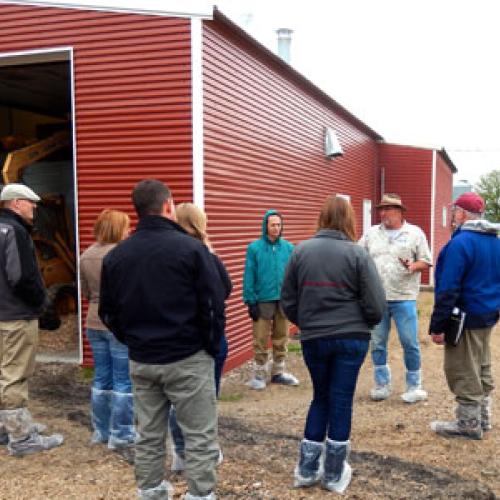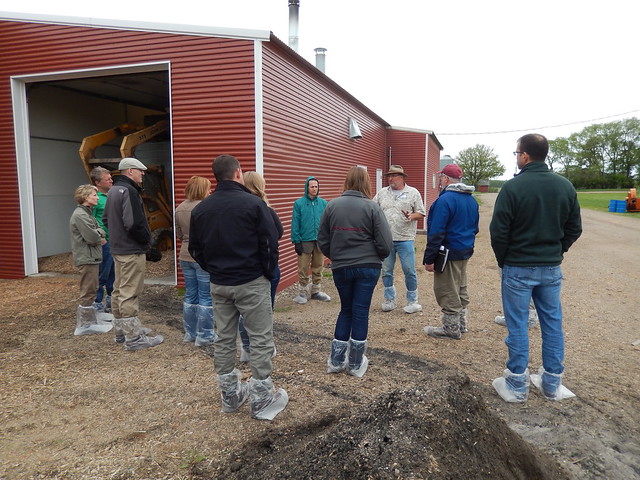On May 19, 2017, Clean Energy Resource Teams (CERTs) and AURI (Agricultural Utilization Research Institute) hosted a group of 30 folks at Hillcrest Restaurant in Albany, MN that heard presentations on commercial biomass heating and then headed out to the nearby Viking Company farm for a demonstration tour of their biomass-heated poultry barn.
Continue reading for overviews of each presentation, links to slides and program resources, and photos from the event.
Biomass for Poultry: A Minnesota Case Study at Viking Company
First-up, Fritz Ebinger, Rural Energy Program Manager at CERTs, shared the results of a wood heating system on Viking Company’s broiler chicken growing operation. This technology offers commercial poultry growers the opportunity to beat their peers on input costs with a cost-effective, local, and renewable fuel source. The fuel source is hardwood with 15% or lower moisture content and chipped to a size of two inches of less.
The system has been tested over two years against a comparable barn heated with liquid propane (LP). The woody biomass fuel cost is equivalent to buying propane at only $0.53 per gallon, and it keeps those dollars local. The barn runs more efficiently overall, too. The barn heated with LP runs its ventilation fans a lot more than the biomass heated barn in order to exhaust the combustion fumes.
Bill Koenig, owner of Viking Company, says “It comes down to effective cost. That is a key indicator to watch for overall bird health. Even though the birds might be a little heavier in the LP barn, there were fewer of them and their feed conversion wasn’t as good as in the biomass barn.” The improved performance may be a result of the improved atmosphere in the biomass barn. All told, air quality was a little better in the wood heat barn – less carbon monoxide, less ammonia, and more oxygen.
Biomass is great for fine-tuning a barn’s conditions. Koenig adds, “If I need to dry out the barn quickly, I can pour on the gold.” Bill’s referring to the cheaper fuel –wood chips– that also provides a dryer heat than LP provides. The biomass results in less oscillation of temperatures and a more even heat throughout the barn.
Biomass Opportunities for Agricultural Operations: Feed, Fuel, and Bedding
Next, Alan Doering, Senior Scientist of AURI, started out commending “Biomass Burnin’ Bill” in being an excellent partner to try out this heating method of a poultry barn. AURI provided air quality testing, smoke stack testing, ash analysis, monitoring equipment, and education and outreach for the Viking Company wood heating project. Alan also highlighted the versatility of biomass through several case examples. Did you know, aside from heating, biomass can be used for poultry bedding, biofilters, potting soil blends, and so much more? AURI focuses on local projects and helps Minnesota businesses get off the ground through applied research and development, hands-on scientific analysis, and innovative networking. For example, in addition to assisting the Viking Company’s wood heating project, AURI is assisting a farmer that bought their own mill to make pellets for biomass fuel.
Financing Opportunities: PACE, MDA, and USDA
Lastly, Pete Lindstrom, Local Government Outreach Coordinator with CERTs, explained Property-Assessed Clean Energy (PACE) and showed examples where PACE financing helped make projects happen. PACE is a financing tool that businesses and organizations can utilize to finance energy efficiency and renewable energy projects with no upfront costs. Utilizing solar on farms is one of the most popular types of PACE projects. Pete mostly wanted to be sure that everyone knows PACE exists – it’s another tool in the financing toolbox! PACE can absolutely be layered with other funds, like private capital and grants.
Fritz took the stage one last time to spread the word about United States Department of Agriculture (USDA) and Minnesota Department of Agriculture (MDA) funding programs. USDA’s Rural Energy for America Program (REAP) grant can cover 25% of project costs and a project can begin after an application has been submitted. Applications are due October 31, 2017 for projects less than $80k and April 1, 2018 for projects of any size. REAP grants are competitive (1 in 4 applicants awarded). However, USDA appreciates seeing biomass projects in the mix of applications. USDA’s Guaranteed Loan provides up to 75% of project costs and is not competitive. An audience member asked about the MDA Biomass Thermal Energy Incentive Program. This is a production-based incentive and pays out based on heat generated by mostly Minnesota-sourced biomass. MDA’s Livestock Investment grant covers 10% of a project’s eligible costs. The application period is September through December, and while it is a competitive grant, more than half the applicants are awarded funds.
The Tour
After the presentations, attendees caravanned to the Viking Company farm for a demonstration of the wood heating system. Attendees toured the newly constructed service building appended to the barn and containing the biomass furnace and its related equipment. Attendees also examined the wood fuel storage bunker containing different fuel types. Koenig showed off the system and the modifications he has made to it ensure prime operation.



